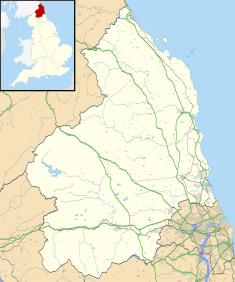Ashington Town Hall is a municipal building in Station Road in Ashington, Northumberland, England. The town hall, which was the headquarters of Ashington Urban District Council until 1974, is now the base of Ashington Town Council.
| Ashington Town Hall | |
|---|---|
 Ashington Town Hall | |
| Location | Ashington |
| Coordinates | 55°11′01″N 1°34′27″W / 55.1836°N 1.5741°W |
| Built | 1913 |
| Architectural style(s) | Neoclassical style |
History edit
After significant industrial growth in the second half of the 19th century, particularly in relation to the coal industry, Ashington Urban District Council was formed in 1896.[1] The new civic leaders decided to procure dedicated council chambers: the site chosen was open land between Ashington Colliery to the west and Ashington railway station to the east.[2]
The foundation stone for the new building was laid by the mayor, Councillor W. Miller, on 19 April 1911.[3] It was designed in the neoclassical style and was completed in 1913.[4] The design involved an asymmetrical main frontage with five bays facing onto Station Road; the central bay, which slightly projected forward, featured a doorway with brackets supporting a cornice; there was a triple window on the first floor and an open pediment containing a carved garland.[4] There was a clock tower with a lantern at the north west corner of the building,[4] which was fitted with an hour-striking clock by Potts.[5]
After a significant increase in the number of council employees, the council chambers were completely reconstructed at a cost of £9,000 in 1937.[6][7] While the façade of the old building was retained the changes were significant: an extra floor was added, the old clock tower was demolished and a new clock tower rose from above the doorway.[8] The clock and strike were electrified by Charles Potts & Co.,[5] and four new bells by John Taylor & Co of Loughborough were added to sound the quarter chimes.[9] The building remained the headquarters of the urban district council for much of the 20th century and became known as Ashington Town Hall.[10]
The footballers, Jack and Bobby Charlton, visited the building for a civic reception on 18 August 1966 to celebrate England's win in the 1966 World Cup.[11][12] The building ceased to be the local seat of government when the enlarged Wansbeck District Council was formed in 1974.[13] However, a programme of remedial works to the clock tower were completed in September 2006[14] and Ashington Town Council established its base in the building shortly after it was formed in 2010.[15] A further programme of refurbishment works for the interior of the building was completed in September 2014.[16]
References edit
- ^ "Ashington Tn/CP". Archived from the original on 30 September 2007. Retrieved 30 November 2020.
- ^ "Ordnance Survey Map". 1897. Retrieved 30 November 2020.
- ^ Foundation stone laid by Councillor W. Miller on the Station Road elevation of the building
- ^ a b c "Council Chambers, Ashington, Northumberland c1913". JB Picture Archive. Retrieved 30 November 2020.
- ^ a b Potts, Michael S. (2006). Potts of Leeds: Five Generations of Clockmakers. Ashbourne, Derbyshire: Mayfield Books. p. 208.
- ^ Michael, John (1982). "Housing, class and politics: Ashington 1896-1939" (PDF). Durham University. pp. 111, 140. Retrieved 30 November 2020.
- ^ Commemorative stone laid by Councillor George Bowen on the Council Road elevation of the building
- ^ "Clock tower and council chambers on Station Road, Ashington, Northumberland". Alamy. Retrieved 30 November 2020.
- ^ "Ashington Town Hall". North East Bells. Retrieved 30 November 2020.
- ^ "No. 46036". The London Gazette. 26 July 1973. p. 8773.
- ^ "Watch Ashington legends Bobby and Jack Charlton's 1966 World Cup-winning homecoming". Chronicle Live. 11 May 2015. Retrieved 30 November 2020.
- ^ "Jack Charlton's hometown campaigns for statue". BBC. 18 July 2020. Retrieved 30 November 2020.
- ^ Local Government Act 1972. 1972 c.70. The Stationery Office Ltd. 1997. ISBN 0-10-547072-4.
- ^ "Ashington". Chronicle Live. 19 September 2006. Retrieved 30 November 2020.
- ^ "Evaluation of Fair Share Trust in Wansbeck (East Ashington)" (PDF). Barefoot Research. 1 February 2013. p. 15. Retrieved 30 November 2020.
- ^ "Full Council" (PDF). Ashington Town Council. 9 September 2014. Retrieved 30 November 2020.
